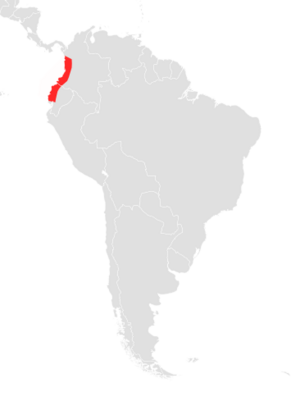Hairy little fruit bat facts for kids
Quick facts for kids Hairy little fruit bat |
|
|---|---|
| Conservation status | |
| Scientific classification | |
| Genus: |
Rhinophylla
|
| Species: |
alethina
|
 |
|
The hairy little fruit bat (Rhinophylla alethina) is a small type of bat. It belongs to the Phyllostomidae family, also known as the New World leaf-nosed bats. These bats live in parts of Colombia and Ecuador.
Hairy little fruit bats are nocturnal, which means they are active at night and sleep during the day. The IUCN lists them as near-threatened. This means their numbers are decreasing, and they might become endangered if we don't protect them.
Contents
What is a Hairy Little Fruit Bat?
The hairy little fruit bat is a fascinating creature. It gets its name from the soft, furry coat covering its body. Like all bats, it is a mammal and the only mammal that can truly fly!
Where Do They Live?
These bats are found in South America. Their known homes are in the countries of Colombia and Ecuador. They prefer tropical forests where they can find plenty of fruit to eat.
What Do They Eat?
As their name suggests, hairy little fruit bats mainly eat fruit. They are important for their environment because they help spread seeds. When they eat fruit, they often drop the seeds in new places, which helps new plants grow. This process is called seed dispersal.
Bat Behavior
Bats have many unique behaviors that help them survive.
Nocturnal Life
Being nocturnal means these bats are awake and busy when most other animals are sleeping. They use the darkness to hunt for food and avoid predators. During the day, they find safe places to rest, often hanging upside down in trees or caves.
Echolocation
Many bats, including some fruit bats, use a special skill called echolocation. This is like having built-in sonar. Bats send out high-pitched sounds that humans cannot hear. When these sounds hit an object, they bounce back as echoes. The bat listens to these echoes to create a mental map of its surroundings. This helps them fly in the dark and find food.
Conservation Status
The hairy little fruit bat is currently listed as "near-threatened." This status is a warning sign.
Why Are They Near-Threatened?
The main reasons bats like the hairy little fruit bat become threatened are often related to their habitat.
- Habitat Loss: Forests where they live are sometimes cut down for farming or building.
- Climate Change: Changes in weather patterns can affect the availability of their food (fruit).
- Human Activity: Sometimes, human activities can disturb their roosting (sleeping) places.
How Can We Help?
Protecting bats is important because they play a vital role in their ecosystems.
- Protecting Forests: Keeping their forest homes safe is crucial.
- Research: Scientists study bats to learn more about them and how to protect them.
- Awareness: Learning about bats and sharing that knowledge helps others understand why they are important.
Images for kids
See also
 In Spanish: Rhinophylla alethina para niños
In Spanish: Rhinophylla alethina para niños



